Find out why more people are choosing them as an alternative to Ti:Sapphire lasers.
Written by our Femtosecond Fibre Laser specialist, Karen McGeachy, this blog is aimed to help you understand the benefits that fixed wavelength femtosecond fibre lasers offer to your two-photon microscopy setup.
We will cover the following topics:
- Brief overview of two-photon microscopy
- This section details the principle of two-photon microscopy and why it is used.
- Ti:Sapphire lasers, the traditional excitation laser
- This section provides an overview of the traditional two-photon laser and why it was suitable.
- Can fibre lasers be used as an alternative?
- This section explores the feasibility of using a femtosecond fibre laser in two-photon microscopy.
- Why should people choose fibre lasers?
- This section provides a comparison of Femtosecond Fibre Lasers vs Ti:Sapphire lasers and explores the difference in wavelength and power, price, and maintenance and form factor.
- Key specifications of the SPARK LASERS ALCOR series for two-photon microscopy
- This section goes into details of the features of the ALCOR which makes it particularly beneficial for two-photon microscopy such as GDD precompensation, adjustable power and triggering, and fibre coupling.
Written by Karen McGeachy
5-10 minutes Read
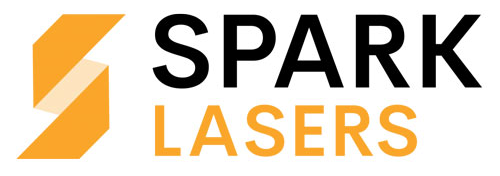
1. Brief Overview of Two-Photon Microscopy
Two-Photon Microscopy is an imaging technique which is particularly useful for imaging thick tissues. Typical fluorescence microscopy uses visible wavelengths as the excitation light. However, the common biological molecules found in tissue absorb heavily in this wavelength range [Fig. 1]. Rayleigh scattering is also an issue because it scales as a function of 1/λ^4. Therefore visible wavelengths cannot be used for imaging depths more than ~ 200um.
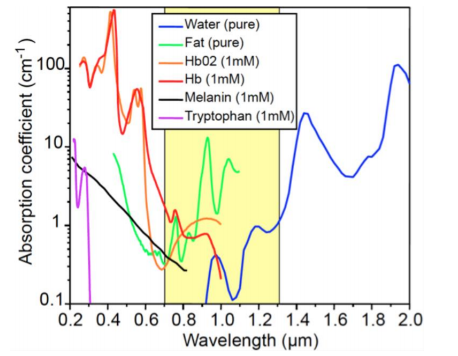
In order to image deeper into samples, NIR light needs to be used due to absorption and scattering being greatly reduced in this range. One issue with using NIR light is that the common fluorescent proteins used as markers are optimised for the visible range and have their absorption bands in this wavelength regime.
The principle of two-photon microscopy is that you can use two photons of the same wavelength in the NIR to provide the same energy as one photon in the visible [Fig.2]. i.e. 2 photons at 900nm have the same energy as 1 photon at 450nm. In order for this effect to take place, the photons have to arrive nearly simultaneously (<1fs) and the fluorescence intensity depends on the square of the excitation intensity. This nonlinearity only produces fluorescence from the focal point of the two photons as this is the only place that has enough intensity for fluorescence to occur. The advantage of this is that no out of focus light is produced so you can collect all of the emission light intensity without imaging, and assign it to the focus. By not imaging you are not limited to the framerate of a camera and your detection optics are much simpler. To create an image you simply raster scan the laser over the sample and record the intensity at each point. It is essentially a confocal microscope but without the pinhole. With two-photon microscopy, you have the ability to image depths up to ~1mm.
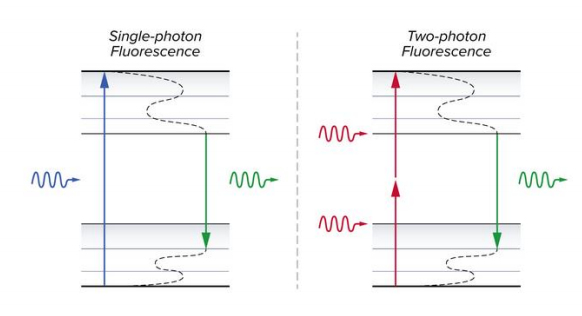
2. Ti:Sapphire lasers, the traditional excitation laser
As mentioned above, the two photons need to arrive almost simultaneously and fluorescence depends on the square of the laser intensity. To achieve this, a femtosecond laser with a high excitation power and repetition rate is needed.
Traditionally the laser that could achieve this was a Ti:Sapphire. Not only did it have suitable specifications of ~80fs pulse duration, 80 MHz repetition rate and average powers ~1-2.5W, but the laser is also tuneable between ~ 700-1000nm which was seen as a big advantage as you can excite a range of fluorophores with it. The technology behind Ti:Sapphire lasers is a titanium doped sapphire crystal pumped with an argon-ion laser (514.5nm) or a frequency doubled Nd doped laser in the 527-532nm wavelength regime.
3. Can fibre lasers be used as an alternative?
In recent years, developments in fibre laser technology has come on tenfold. The large gain bandwidth of rare-earth doped fibres, such as ytterbiurm, enables the generation of femtosecond pulses. With the combination of an amplifier, high power and high pulse energies can be achieved. These lasers are of fixed wavelengths and in the case of two-photon microscopy these wavelengths are at 920nm and in the ~1um regime (1040-1070nm).Typical specifications of these ultrafast fibre lasers are <100fs pulse duration, 80MHz repetition rates, average powers ~ 1-2W (or up to 4W in the case of the ALCOR by SPARK LASERS).
4. Why should people choose fibre lasers?
Even though Ti:Sapphire lasers are tuneable, they have a peak lasing efficiency at around 780nm and their average power decreases in the 800-1000nm spectral range. For two-photon microscopy, researchers now tend to use specific fluorescent proteins such as GFP, tdTomato and MCherry which have absorption bands in the 900 – 1100nm range [Fig.3].

It has also been shown that the damage to tissue is greatly reduced when using 920nm compared to 780nm [1]. Therefore users typically tune their Ti:Sapphire to 920nm or the 1um range. With SPARK LASERS’ release of the 4W 920nm and 1064nm ALCOR they can achieve substantially higher excitation power therefore increasing your fluorescence intensity, producing a better image.
Price:
Due to the high pump laser power needed, the optics inside and the technology needed to produce the femtosecond pulses of the Ti:Sapphire laser, pricing of the system is between £100-£150k.
In contrast, although fibre lasers do have a fixed wavelength they are reasonably low cost and for <£80k you can purchase both a 920nm and a 1064nm source which would allow you to work with almost all of the common fluorescent proteins.
Maintenance and form factor:
Maintenance is also required in order to keep the Ti:sapphire laser functioning at peak efficiency, such as realigning the laser and replacing the pump laser and the crystal occasionally. The form factor for the laser system is also relatively large, often spanning half of an optical table.
Fibre lasers have no required maintenance or alignment constraints, therefore downtime is kept to a minimum. The process of unpacking and having a fully working laser takes <5 minutes. Due to the nature and flexibility of fibre they are also able to have a small form factor, being no larger than a shoe box. Perfect if you are lacking space in the lab.
Fibre lasers can achieve fantastic two-photon images, the following [Fig 4] is a side by side comparison of skin tissue taken using SPARK LASERS ALCOR 920nm laser and a Ti:Sapphire laser. Both experiments were carried out under the same conditions.
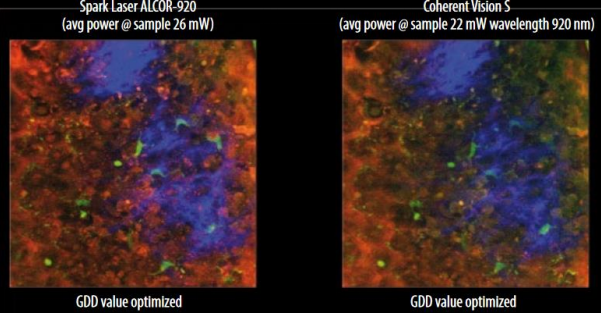
The Ti:Sapphire laser was tuned to 920nm and both lasers were GDD optimised using the features available for each laser. For more information on GDD please see below. The ALCOR produces a higher contrast image proving that fibre lasers are effective and can even outperform traditional lasers in two-photon microscopy
5. Key specifications of the SPARK LASERS ALCOR series for two-photon microscopy
o GDD precompensation:
A common problem with using femtosecond lasers is Group Delay Dispersion. When a narrow band of light pulses through an optic it experiences a time delay and the frequency dependency of this time delay is referred to as the GDD of the optic. A two-photon microscope has a number of optics in which the laser passes through so therefore the pulse is broadened. This value differs depending on the microscope but is generally >2000fs^2 at 800nm [2]. This therefore reduces the peak power of the laser which in turn reduces the probability of the two-photon effect occurring.
To combat this, most two-photon lasers have an option called GDD precompensation. This allows the user to take into account the effects the optics will have on the pulse duration and modify it to negate the effects using a pulse compressor. Some manufacturers have this GDD precompensation fixed based on the average value of GDD in microscope systems, however the ALCOR allows for user adjustment to -90,000fs^2. This is especially useful for home built microscopes as it gives you the flexibility to tailor the pulse specifically for your needs.
o External AOM
Most femtosecond lasers for two-photon microscopy have a fixed power output. However, depending on the application and tissue type it can be advantageous to modulate the power to allow for optimal imaging and cell preservation. Typically to do this, users would need to add a Pockel Cell to their setup. A Pockel cell is made up of an electro-optic crystal which modulates the phase delay when a varying electric voltage is applied. They effectively act as a waveplate that can be voltage-controlled. Due to this effect, they have a high power loss and can be cumbersome to align.
The ALCOR series offers an integrated external Acousto-Optic Modulator (AOM) instead of a Pockel cell. This allows for power control set electronically through the GUI or through the serial port. With the AOM analogue power modulation from 0 to 100% is achieved as well as modulation by TTL signal which allows for gating ON and OFF. The efficiency of this AOM is >75% so the power loss is not as high as the Pockel cell. As it is pre-aligned and is essentially an add-on to the laser module, pointing stability and polarisation are not affected. The system still maintains a small footprint [Fig 5].
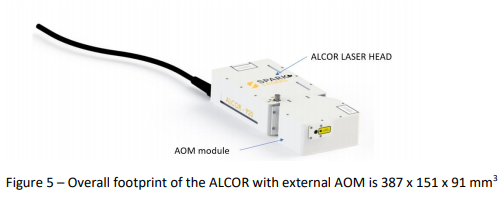
o Fibre coupling
For users who want to address the sample directly with the laser not have it coupled into the microscope, the ALCOR series can also be fibre coupled. This gives more flexibility over the whole system and again is useful for both home built set ups or adapted set ups which were not originally designed for two-photon microscopy. This is especially useful for live animal imaging in which the animal needs to be able to move around freely. With the fibre coupling we can achieve >50% coupling efficiency.
References:
[1] K. Koenig: Multiphoton microscopy in life sciences”, Journal of Microscopy 200 (2000) Pt 2, 83 -104 [2] Handbook of Biological Confocal Microscopy: Mark B. Cannell, Angus McMorland, and Christian Soeller
6. Summary
Hopefully, above we have answered some of the questions asked by our customers and shown the benefits of choosing fibre lasers as an alternative to Ti:Sapphire lasers in two-photon microscopy. Below is an overview of the various femtosecond lasers and links to the datasheets.
| Series | Wavelength | Avg Power/pulse energy | Pulse duration | Repetition rate |
| ALCOR | 920nm/1040nm (other optional) | Up to 4W | <100fS | 80MHz (other optional) |
| ALTAIR | 1040nm (other optional) | Up to 20W | <160fs | 80MHz (other optional) |
| DIADEM | 1030nm/1060nm | Up to 40µJ | <400fs (typ. 350fs) to 10ps | Single pulse to 2MHz (with burst mode) – single shot to 40MHz (optional) |
Want a loan unit to test in your application?
Contact us here:
Other Blogs/Articles that may be of interest:































